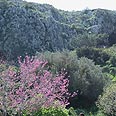
Nahal Me'arot
צילום: יואב גלזנר
Nahal Me'arot recognized as World Heritage Site
UNESCO adds set of caves containing evidence of early human societies to prestigious list
UNESCO branded northern Israel's Nahal Me'arot Nature Reserve as a World Heritage Site on Friday.
Located on the western slope of the Mount Carmel range, the reserve's caves provide evidence of several early human cultures that span over 500,000 years.
The global cultural agency's World Heritage Committee, which last week launched its 36th annual session in Saint Petersburg, Russia, defined the reserve as a "key site" that illustrates a fascinating link in human evolution.
The site includes four caves – Tabun, Jamal, el-Wad and Skhul – and contains evidence of burials, early stone architecture and the transition from a hunter-gathering lifestyle to agriculture and animal husbandry. The site further uniquely demonstrates the existence of Neanderthals and Early Anatomically Modern Humans.
Nahal Me'arot joins a distinguished line of Israeli World Heritage Sites, including Masada, Tel Aviv's White City, the Old City of Acre, the Biblical Tels (prehistoric settlement mounds) and the southern Incense Routes. Among the global sites honored by the agency are the Parthenon in Greece, the pyramids in Egypt, the Pisa Tower in Italy and the Chinese Wall.
The nature reserve, which has been open to the public since 1989, is visited by some 50,000 primarily local travelers. The Israel Nature and Parks Authority (INPA) expressed hope that the attraction's new title could boost the number of foreign and local visitors.
"This is very exciting," Dr. Tzvika Tzuk, the INPA's chief archeologist, said of the honor. "This is a four-year project that has been concluded with a hit of a gavel… Since 2008 no Israeli site has been declared as a World Heritage Site. This is a moment of great pride for Israel."
"I'm glad that UNESCO has set political discord aside and recognized another Israeli World Heritage Site," said Shaul Goldstein, who heads the INPA.
The campaign to achieve recognition for the reserve was waged by the INPA, the Hof HaCarmel Regional Council, Haifa University, the Israel Antiquities Authority and UNESCO's representatives in the Jewish state.
Also among the World Heritage Sites recognized on Friday was the Nativity Church in Nazareth, which caused controversy because it was the first site to be listed under Palestine.










